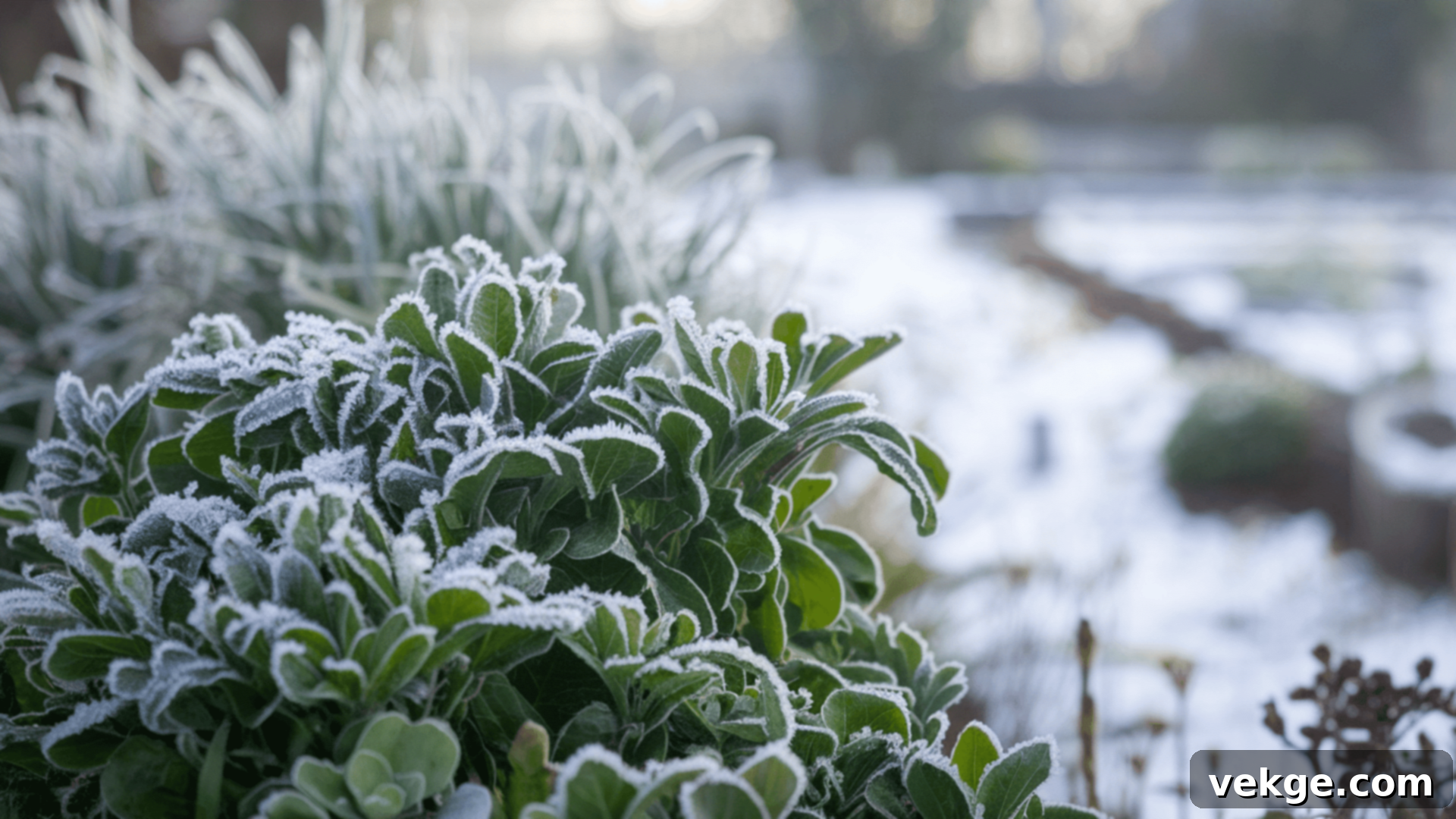Mastering Winter Gardening: Your Ultimate Guide to Growing Fresh Produce All Year Long
Many gardeners believe that once autumn leaves fall, their season is over. However, winter gardening is not only possible but also incredibly rewarding. Far from being a difficult task, cultivating a vibrant garden through the colder months is surprisingly straightforward with the right knowledge and techniques. Instead of letting your garden beds lie dormant and empty, imagine harvesting fresh, delicious vegetables and aromatic herbs all season long, even when snow blankets the ground outside.
The Undeniable Benefits of Embracing Winter Gardening
Venturing into winter gardening offers a unique set of advantages that can transform your gardening experience and provide fresh food even in the chilliest months.
- Consistent Fresh Produce: Enjoy a continuous supply of healthy, organic vegetables and herbs, eliminating the need to rely solely on store-bought options that may have traveled long distances.
- Fewer Pests and Weeds: Colder temperatures naturally suppress many common garden pests and weed seeds, meaning less time spent on pest control and weeding, and more time enjoying your harvest.
- A Green and Lively Space: Keep your garden alive and thriving through winter, adding a touch of green beauty and a sense of accomplishment during an otherwise bleak time of year.
- Enhanced Flavor: Many cold-hardy vegetables, such as kale and carrots, develop a sweeter, more intense flavor after being exposed to light frost, as the cold converts starches into sugars.
- Year-Round Connection to Nature: Maintain your connection to the earth and the therapeutic benefits of gardening, even when the rest of the world is bundled up indoors.
Debunking Common Winter Gardening Misconceptions
Before diving in, let’s address some common myths that often deter aspiring winter gardeners:
- “Nothing grows in winter.” This is simply untrue. A wide variety of plants are specifically adapted to thrive in cold weather, and many even prefer it, growing more robustly and developing richer flavors.
- “Frost ruins everything.” While severe frost can be damaging, proper protection methods can easily keep your plants safe and productive. Techniques like mulching, row covers, and cold frames are highly effective.
- “It’s too much work.” Winter gardening can be as simple or as complex as you make it. With smart plant choices and basic protective measures, it doesn’t require significantly more effort than summer gardening, often less due to fewer pests.
With the right setup and a bit of planning, you can easily enjoy the joys of gardening all year long, transforming your winter garden into a productive and vibrant oasis.
Step-by-Step Winter Garden Setup
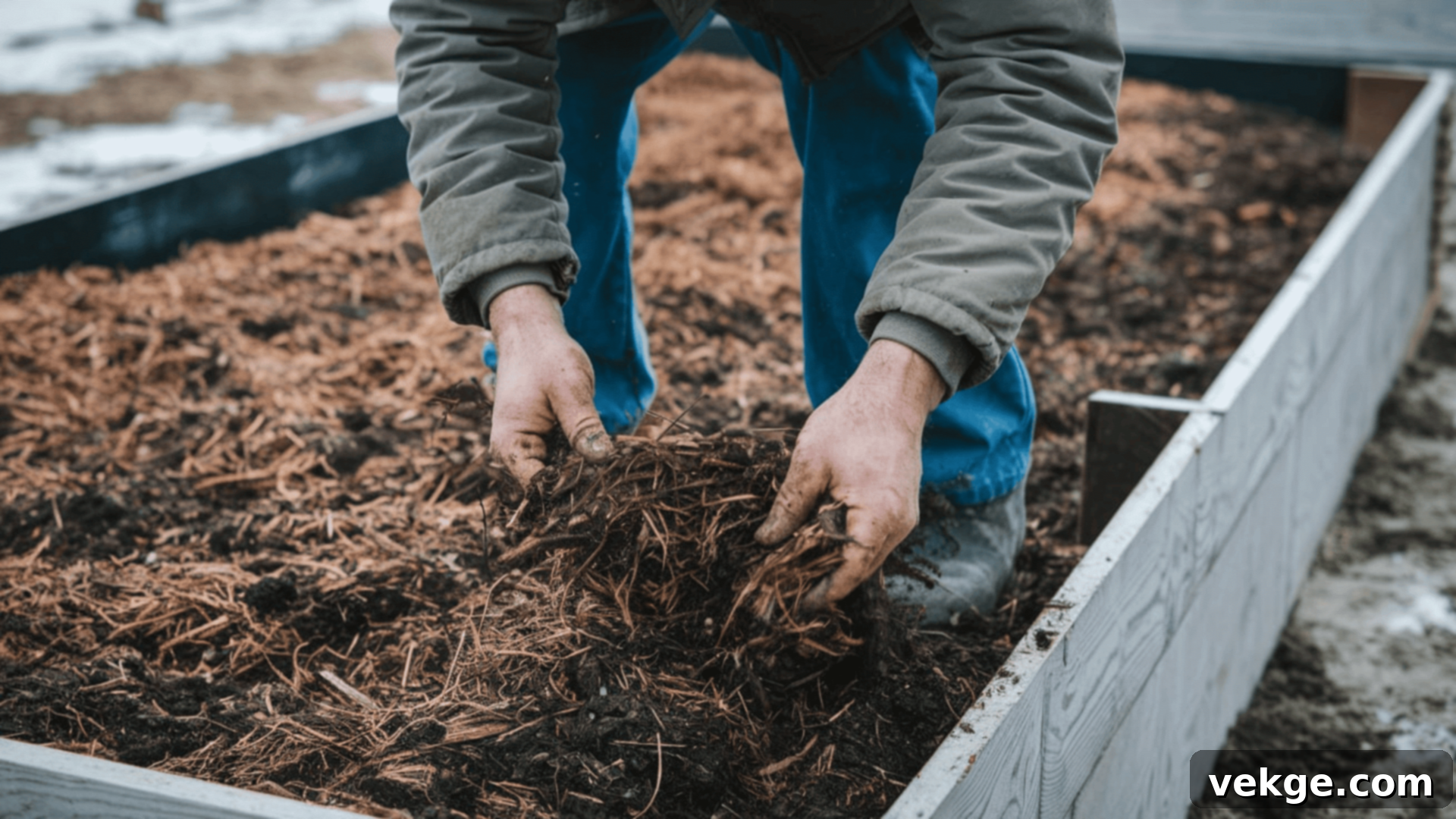
Choose the Right Location
Selecting the ideal spot for your winter garden is paramount for success. Aim for an area that receives at least six hours of direct sunlight each day. In winter, the sun’s path is lower, so observe your garden to identify the sunniest spots. Avoid low-lying areas where water tends to collect, as this can lead to waterlogged soil that freezes easily, potentially damaging plant roots. If possible, plant your winter crops near a south-facing wall or fence. These structures act as natural windbreaks, shielding delicate plants from harsh cold winds, and also absorb solar heat during the day, radiating it slowly at night to create a warmer microclimate for your plants.
Prepare the Soil
Healthy, well-prepared soil is the foundation of any thriving garden, especially in winter. Before planting, significantly enrich your soil by mixing in a generous amount of well-rotted compost. Compost adds essential nutrients, improves soil structure, and enhances drainage, preventing roots from sitting in overly wet, cold soil. Raised beds are an excellent option for winter gardening because they warm up faster in the spring sun and provide superior drainage compared to ground-level beds. Additionally, once planted, applying a thick layer of organic mulch (like straw or shredded leaves) over the soil surface will insulate the soil, helping to retain warmth and keep it from freezing too quickly, protecting delicate root systems.
Select the Best Gardening Method
The method you choose for your winter garden will depend on your space, climate, and desired level of protection. Raised beds remain a top recommendation due to their excellent drainage and ability to retain warmth. They also offer better control over soil quality. If you have limited outdoor space, container gardening provides incredible flexibility. Potted plants can be easily moved indoors or into a sheltered area during extreme cold snaps, allowing you to protect them more effectively. For enhanced protection and a significantly extended growing season, consider investing in or building greenhouses or cold frames. These structures create a more controlled environment, trapping solar heat and shielding plants from the elements, making them ideal for growing a wider variety of crops through winter.
Pick Cold-Hardy Plants
The key to a successful winter garden lies in choosing plants specifically adapted to cooler temperatures. Leafy greens such as kale (especially varieties like ‘Red Russian’ or ‘Siberian’), spinach, arugula, and collards thrive in chilly conditions and often taste sweeter after a light frost. Root vegetables like carrots, beets, and turnips are excellent choices because they grow underground, where the soil acts as a natural insulator, protecting them from surface frosts. Hardy brassicas like broccoli, Brussels sprouts, and cabbage are also remarkably resilient and can withstand freezing temperatures, often improving in flavor. Don’t forget herbs; many, including rosemary, thyme, chives, sage, and even some varieties of parsley, will continue to produce through the winter months, providing fresh flavor for your culinary creations.
Protect Plants from Frost
While cold-hardy plants are resilient, extreme cold and frost can still be challenging. Simple protective measures can make a significant difference. Apply a generous layer of organic mulch (straw, shredded leaves, or wood chips) around the base of your plants. This insulates the soil, trapping residual heat and preventing roots from freezing solid. Row covers, made from lightweight fabric, act like a protective blanket, shielding plants from cold winds and trapping warmth close to the plants, while still allowing light and water to penetrate. For additional protection against freezing, water your plants thoroughly in the morning. Moist soil retains heat better than dry soil, and the water absorbs solar energy throughout the day, releasing it slowly overnight. Ensure watering is done early enough so foliage has a chance to dry before evening temperatures drop below freezing.
By implementing these foundational steps, your winter garden can remain productive and healthy, yielding fresh produce even in the coldest months of the year.
Best Vegetables and Plants for Winter Gardening
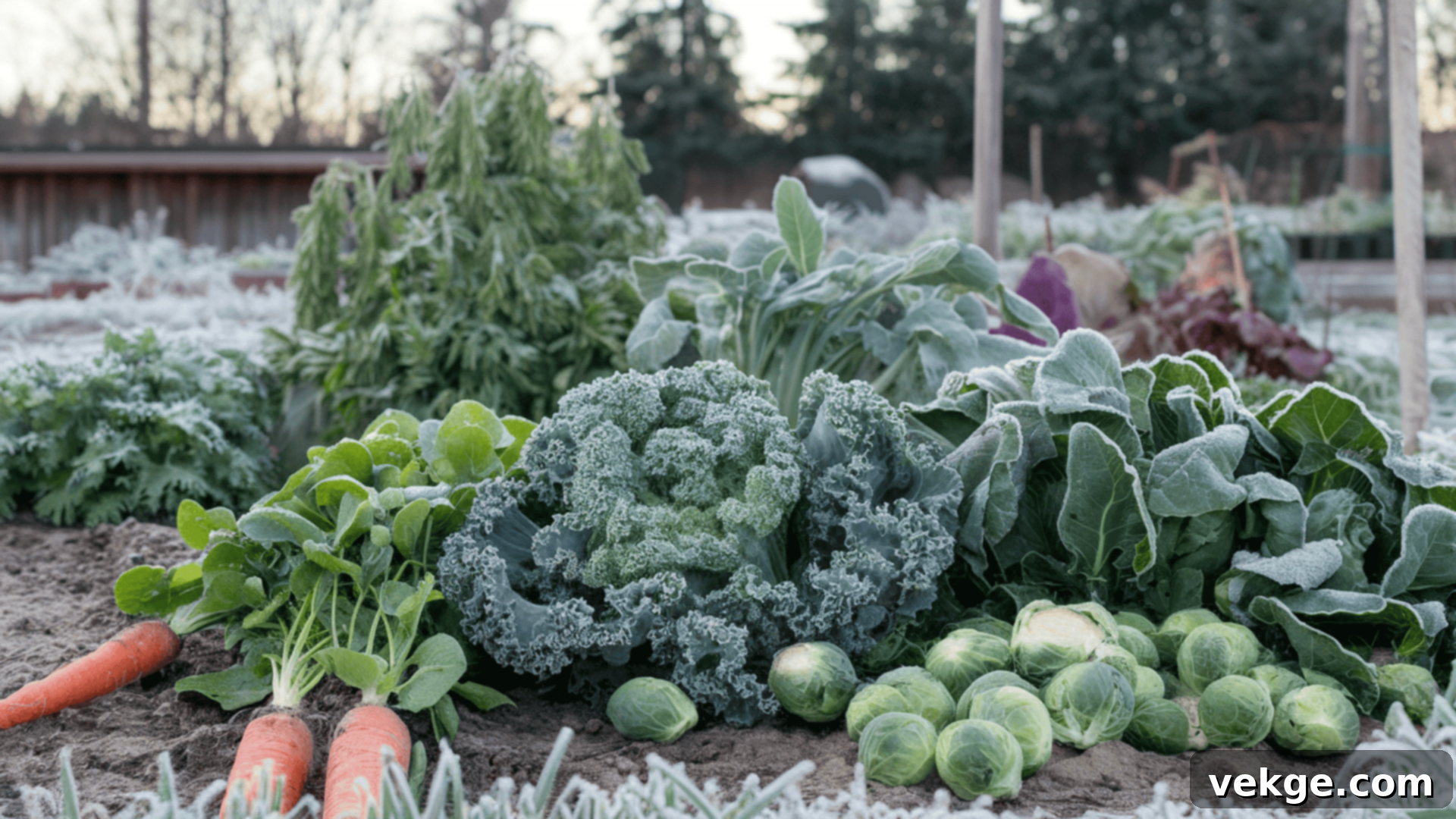
Leafy Greens
Leafy greens are champions of the cool-season garden, flourishing in temperatures that would send many other plants into decline. Varieties like kale, spinach, loose-leaf lettuce, and arugula are not only tolerant of winter conditions but often develop a sweeter, more tender flavor after a light frost. These versatile plants can be harvested using a “cut-and-come-again” method, where you pick the outer leaves, allowing the plant to continue producing new growth from its center, ensuring a continuous supply throughout the season. Varieties such as ‘Winterbor’ kale, ‘Tyee’ spinach, ‘Black Seeded Simpson’ lettuce, and ‘Astro’ arugula are particularly well-suited for winter cultivation.
Root Vegetables
Root crops are naturally insulated by the soil, making them perfect candidates for winter gardening. Carrots, beets, turnips, and parsnips not only survive but often thrive in cold weather. A fascinating benefit of growing these underground treasures in winter is that exposure to frost converts their starches into sugars, resulting in a noticeably sweeter and more delicious flavor. You can often leave these vegetables in the ground until you are ready to harvest them, treating your garden as a living root cellar. Just be sure to apply a thick layer of mulch to prevent the ground from freezing solid, which would make extraction difficult. Consider ‘Danvers Half Long’ carrots, ‘Detroit Dark Red’ beets, and ‘Purple Top White Globe’ turnips for reliable winter harvests.
Hardy Crops
Beyond leafy greens and root vegetables, several other hardy crops are built to withstand the rigors of winter. Broccoli, Brussels sprouts, and cabbage are excellent examples, capable of tolerating freezing temperatures and even light snow. While these plants generally take a longer time to mature, their ability to survive and produce in cold conditions makes them incredibly valuable for a winter harvest. With proper care, including good soil and adequate protection, these robust vegetables can provide substantial yields. Look for ‘Waltham 29’ broccoli, ‘Long Island Improved’ Brussels sprouts, and ‘Late Flat Dutch’ cabbage for varieties known for their cold tolerance.
Herbs That Can Survive Winter
Don’t let winter stop you from enjoying fresh herbs. Many culinary favorites are remarkably tough and will continue to grow, or at least survive, through the colder months. Rosemary, thyme, chives, and sage are particularly resilient and can handle light to moderate frosts. Herbs like parsley and cilantro, while they may slow their growth significantly, will often survive the winter with minimal protection and rebound vigorously in early spring. A great strategy for consistent access to fresh herbs is to grow them in pots. This allows you to bring them indoors to a sunny windowsill when outdoor temperatures drop to extreme lows, ensuring a continuous supply for your kitchen. Consider ‘Bouquet Dill’ for cold tolerance and ‘Italian Giant’ parsley for its robust growth.
By making informed choices about which plants to grow, winter gardening becomes significantly easier and more rewarding. You can truly enjoy a steady supply of fresh, delicious produce all season long by focusing on these cold-hardy vegetables and herbs.
Cold-Weather Gardening Methods
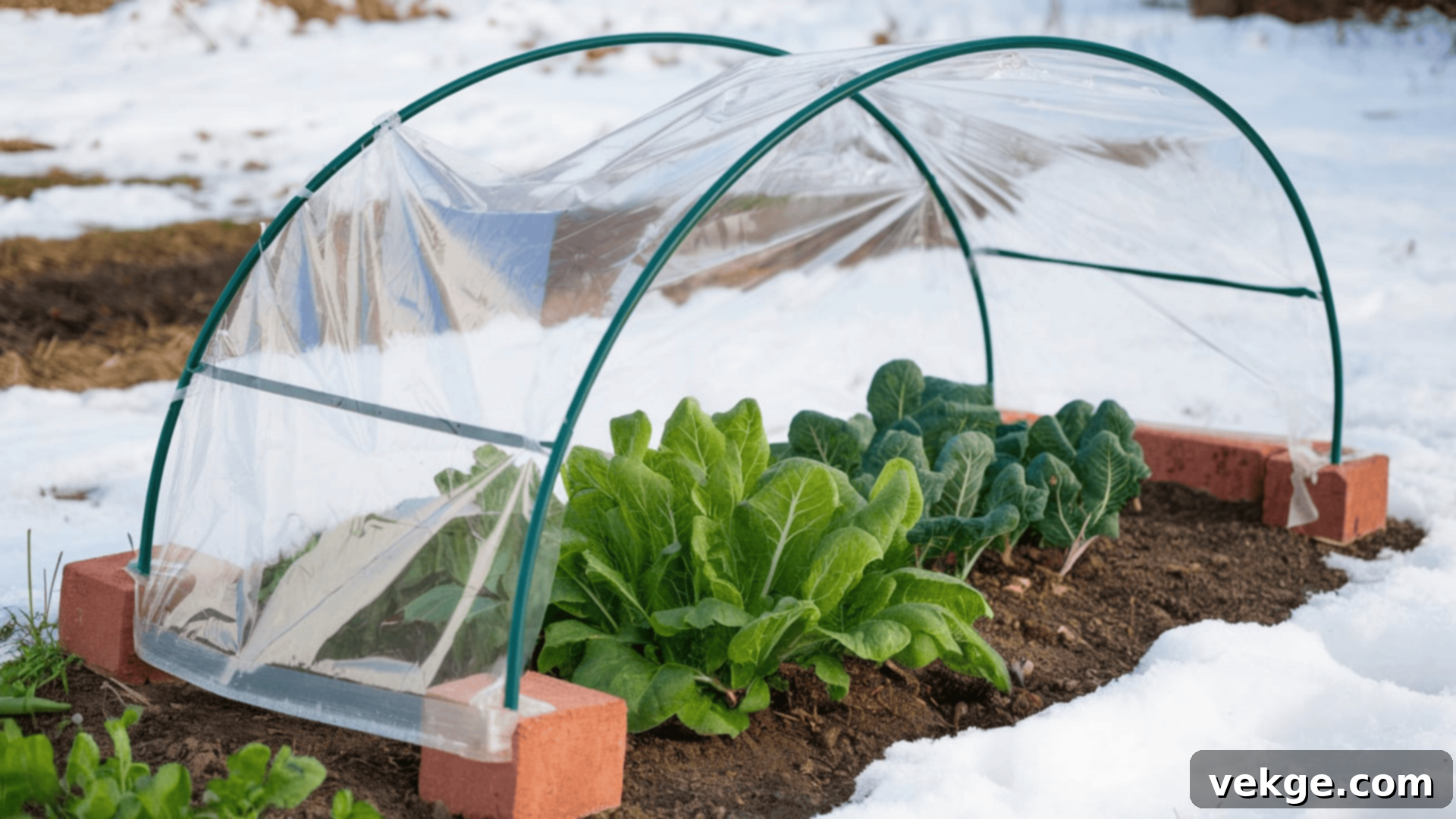
Cold Frames: What They Are and How to Build One
A cold frame is a simple, bottomless box with a transparent lid that acts as a mini-greenhouse, capturing solar energy to warm the soil and protect plants from frost and cold winds. It extends your growing season significantly in both spring and fall, and allows for winter harvesting of very hardy crops. You can easily build one using reclaimed materials like an old window pane or clear plastic sheeting for the lid, and wood scraps, bricks, or straw bales for the frame. Place the cold frame directly over your garden beds or containers. Ensure the lid can be propped open for ventilation on sunny days to prevent overheating and closed securely at night or during extreme cold. This passive solar structure creates a warm, stable environment for many leafy greens and root vegetables.
Row Covers: How They Work and When to Use Them
Row covers are versatile, lightweight fabric sheets (often made of spun-bonded polypropylene) that are draped over plants, either directly or supported by hoops, to shield them from adverse weather. They act as a physical barrier against cold air, biting winds, and frost, effectively raising the temperature beneath by a few degrees. Critically, row covers are permeable, allowing sunlight, water, and air to pass through, so plants can still photosynthesize and receive moisture. They come in various weights; lighter covers offer minimal frost protection but are good for pest control, while heavier covers provide significant frost protection. Use them for most leafy greens, root vegetables, and herbs on nights when frost is expected or for continuous protection during prolonged cold spells. Secure the edges with soil, rocks, or landscape pins to prevent wind from lifting them.
Mini Hoop Houses: DIY Step-by-Step Instructions
Mini hoop houses, also known as low tunnels, are a step up from simple row covers, offering more robust protection and space for taller plants. They are essentially tunnel-like structures created by bending flexible materials like PVC pipes or sturdy wire hoops over your garden beds, then covering them with greenhouse plastic or heavier row cover fabric. These structures effectively trap heat, protect plants from extreme cold, and can even shed light snow.
To build one for your garden:
- Step 1: Install Hoops: Measure your garden bed and cut PVC pipes (typically 1/2-inch or 3/4-inch diameter) into appropriate lengths. Insert the ends of the pipes firmly into the ground along the sides of the bed, spacing them 2-4 feet apart, to create arched hoops.
- Step 2: Drape Covering: Drape a single piece of greenhouse-grade plastic sheeting or heavy-duty row cover fabric over the entire series of hoops, ensuring it extends well beyond the edges of the bed.
- Step 3: Secure Edges: Firmly secure the edges of the plastic or fabric to the ground using heavy bricks, rocks, or soil. This prevents wind from getting underneath and lifting the cover, and also traps warmth effectively. Consider adding clips to secure the plastic to the hoops for extra stability.
This method is excellent for larger winter garden beds, providing a substantial amount of protection and allowing you to grow a wider range of crops.
Greenhouses and High Tunnels: Best for Long-Term Winter Gardening
For serious winter gardeners or those in very cold climates, greenhouses and high tunnels offer the most comprehensive protection. Greenhouses are typically permanent or semi-permanent structures, often featuring rigid panels (glass or polycarbonate) and sometimes equipped with heating and ventilation systems. They create a highly controlled environment where temperatures can be maintained significantly higher than outside, allowing for year-round cultivation of even tender crops. High tunnels, while similar in principle, are usually simpler, temporary structures covered with a single layer of greenhouse film. They are designed to cover a larger area and are often unheated, relying on passive solar gain. Both options allow for an incredible diversity of crops throughout the winter, providing superior conditions for growth and protecting against the harshest elements. While requiring a greater initial investment, the long-term benefits of extended growing seasons and increased yields are substantial.
Utilizing the appropriate cold-weather gardening method is crucial for protecting your plants and maintaining a productive garden, ensuring a steady supply of fresh produce even in freezing temperatures.
Protecting Your Garden from Frost and Snow
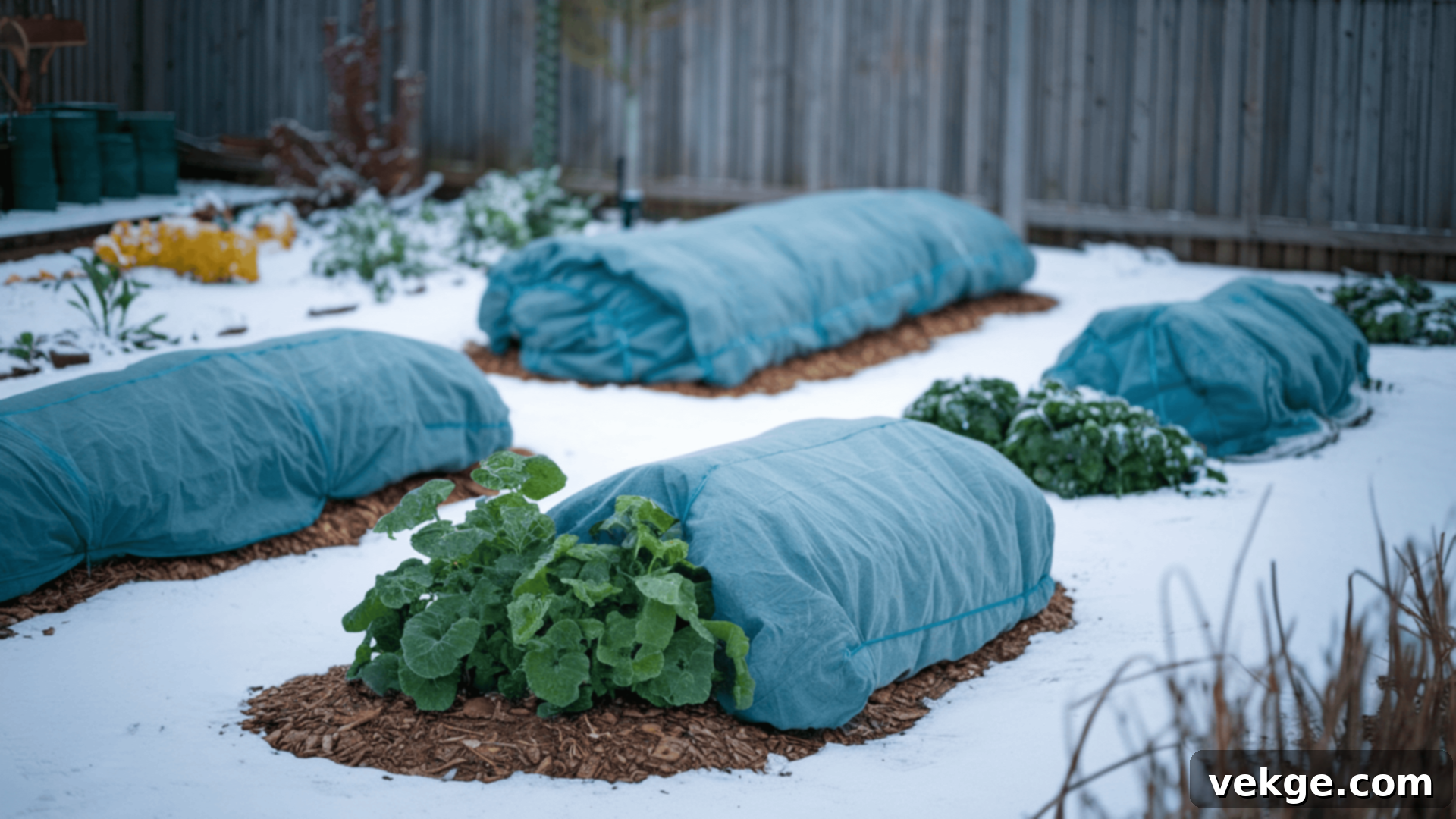
Mulching Techniques for Insulation
Mulch is your garden’s best friend in winter, acting as a crucial insulating blanket for the soil. A good layer of mulch helps to keep the soil warm, preventing deep freezing that can damage plant roots. It also helps to retain soil moisture, crucial in drying winter winds, and significantly reduces temperature swings, providing a more stable environment for delicate root systems.
- Choose the Right Materials: Use organic materials like straw, shredded leaves, or untreated wood chips. Straw is excellent for light-sensitive plants as it doesn’t block too much light, while shredded leaves decompose nicely, adding nutrients back to the soil.
- Apply a Generous Layer: For effective insulation, aim for a 2-4 inch layer of mulch around the base of your plants. In very cold climates, you might even go up to 6 inches, especially for root vegetables left in the ground.
- Mind the Stems: Always keep mulch a few inches away from the stems of your plants to prevent moisture buildup, which can lead to rot and fungal diseases. This also deters pests that might hide in damp mulch and chew on plant bases.
Watering Strategies for Cold Weather
Proper watering is more critical and nuanced in winter than in warmer seasons. Moist soil actually holds heat better than dry soil, acting as a thermal mass that can protect roots from freezing. However, overwatering can be detrimental, as excess water can freeze around roots and cause damage.
- Water in the Morning: The best time to water during cold weather is in the late morning. This gives plants sufficient time to absorb moisture before nightfall and allows any excess water to drain or evaporate, preventing ice formation on leaves or around roots overnight.
- Avoid Overwatering: Check the soil moisture before watering. Stick your finger an inch or two into the soil; if it feels damp, wait. Overwatering can lead to root rot, especially when plants are less actively growing in cooler temperatures. Ensure good drainage.
- Consider Lukewarm Water: On particularly cold mornings, using lukewarm water can give the soil a slight temperature boost, which can be beneficial for less hardy plants or newly transplanted ones. Avoid using hot water as it can shock the roots.
Windbreaks and Plant Covers for Extreme Cold
Harsh winter winds can be incredibly damaging, dehydrating plants and causing “windburn” even without freezing temperatures. Setting up physical barriers can significantly reduce wind damage and help maintain a warmer microclimate around your plants.
- Create Windbreaks: Utilize materials like burlap, sturdy fences, or even strategically planted evergreen hedges as windbreaks around your garden. These barriers deflect or slow down strong winds, protecting vulnerable crops. Burlap can be stapled to stakes to form temporary walls.
- Cover Plants Thoroughly: During periods of extreme cold or heavy snow, cover individual plants or entire beds with row covers, thick cloth sheets, or specialized frost blankets. These provide an extra layer of insulation. For delicate plants, use cloches (bell-shaped covers) or overturned buckets.
- Secure Covers Properly: Always secure your plant covers firmly at the edges, either by weighing them down with rocks, bricks, or soil, or by using clips or stakes. This prevents strong winds from lifting them off, rendering them ineffective and potentially damaging the plants they are meant to protect.
By diligently applying these simple yet effective steps, you can provide robust protection for your plants against winter’s harsh conditions, ensuring your garden remains healthy, productive, and thriving all season long.
Winter Garden Maintenance Tips
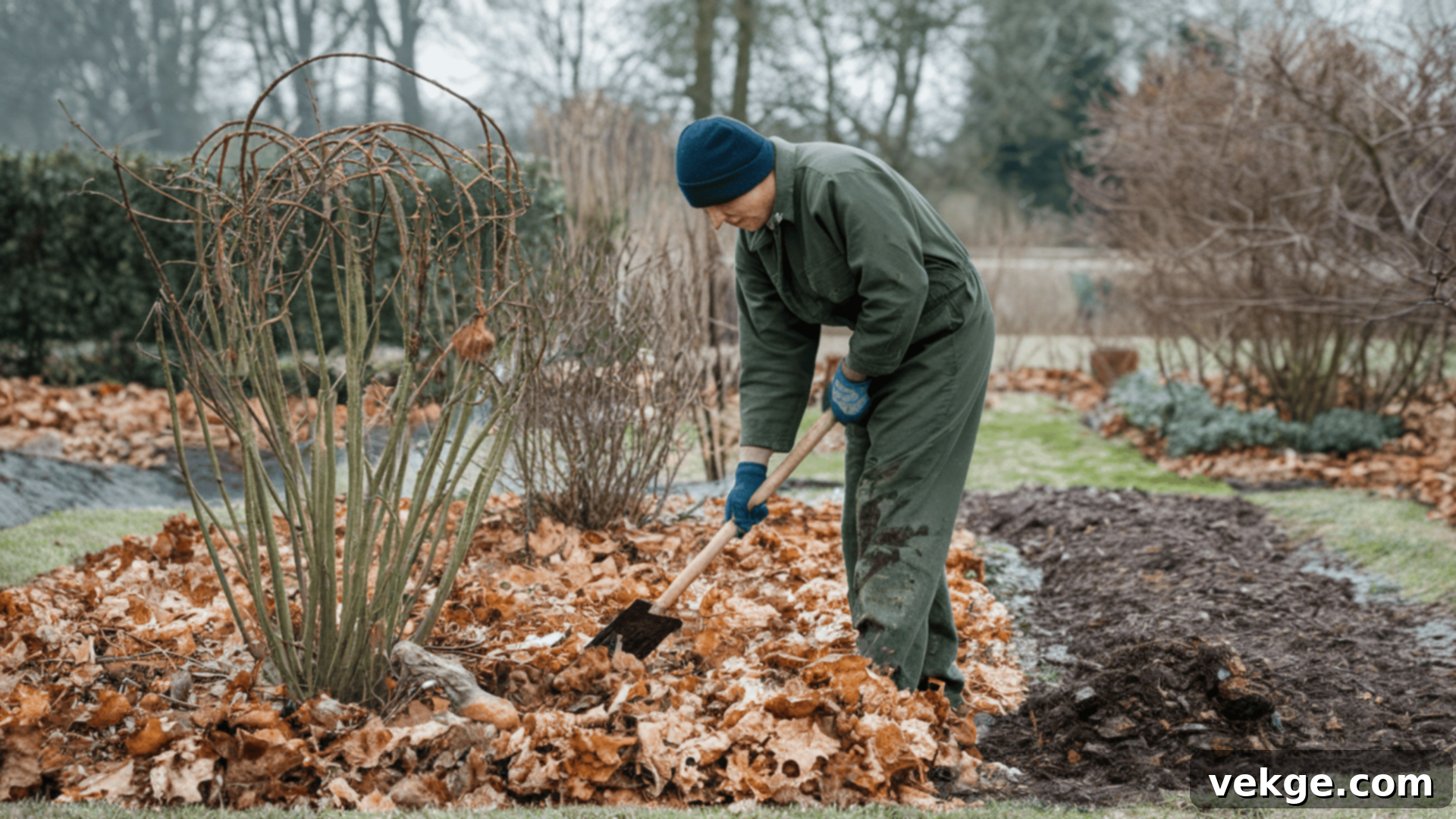
Composting and Soil Care in Winter
Winter isn’t a time for the soil to sleep; it’s an opportune moment to enhance its long-term health and fertility. Enriching your garden beds with compost during the colder months keeps the soil vibrant with microbial life and packed with nutrients, setting the stage for an explosive spring growth.
- Apply a Winter Compost Layer: Before the ground freezes solid, spread a generous 1-2 inch layer of finished compost over your garden beds. This acts as a slow-release fertilizer and protective blanket, improving soil structure and feeding beneficial organisms through winter.
- Utilize Cover Crops: Consider planting ‘green manure’ or cover crops like clover, winter rye, or hairy vetch in unused beds. These protect the soil from erosion, suppress weeds, add organic matter when tilled under in spring, and some (like legumes) even fix nitrogen.
- Avoid Tilling Frozen Soil: Resist the temptation to work or till frozen or very wet soil. Doing so can destroy the delicate soil structure, compact it, and disturb beneficial earthworms and microorganisms, which are vital for soil health.
Pruning and Preparing Perennials
Winter pruning is a vital practice for maintaining the health and vigor of your perennial plants, shrubs, and small trees. Strategic trimming promotes stronger growth in the spring, improves plant shape, and removes potential disease vectors. The approach varies depending on the plant, with some requiring only light tidying and others needing a more significant cutback.
- Remove Dead or Diseased Material: Focus on trimming any dead, damaged, or diseased branches from your shrubs and trees. This prevents the spread of pathogens and improves the plant’s overall health and appearance.
- Cut Back Dormant Perennials: For many herbaceous perennials like lavender, coneflowers, hostas, and peonies, it’s beneficial to cut back their spent foliage after they have gone dormant and the top growth has died back. This tidies the garden and removes hiding spots for pests.
- Leave Some Seed Heads: Resist the urge to cut back everything! Leaving some spent seed heads and stems on plants like coneflowers, sunflowers, and ornamental grasses provides vital food and shelter for birds and pollinators during the lean winter months, contributing to garden biodiversity.
Preventing Pests in Cold Weather
While many garden pests enter a dormant state or die off in winter, some species cleverly hide in garden debris, soil, or under mulch, ready to emerge with the warmth of spring. Taking proactive steps now can significantly reduce pest problems later in the year.
- Clear Plant Debris: Thoroughly remove any fallen leaves, spent annuals, and other plant debris from your garden beds. This eliminates prime overwintering sites for slugs, squash bugs, cutworms, and other common garden pests.
- Inspect Under Mulch: Periodically check under your mulch layers for signs of slugs, aphids, or other overwintering insects. While mulch is beneficial for insulation, it can also create cozy havens for pests. Hand-picking or organic treatments can be applied if necessary.
- Avoid Excessive Mulching: While mulch is essential, applying excessively thick layers (e.g., more than 6 inches unless specifically for deep root insulation) can create attractive habitats for rodents like voles and mice seeking warmth and shelter, which can then gnaw on plant roots and stems.
Consistent and thoughtful maintenance throughout the winter ensures your garden remains healthy, vibrant, and well-prepared for the abundant growing season to come.
Indoor Gardening for Winter
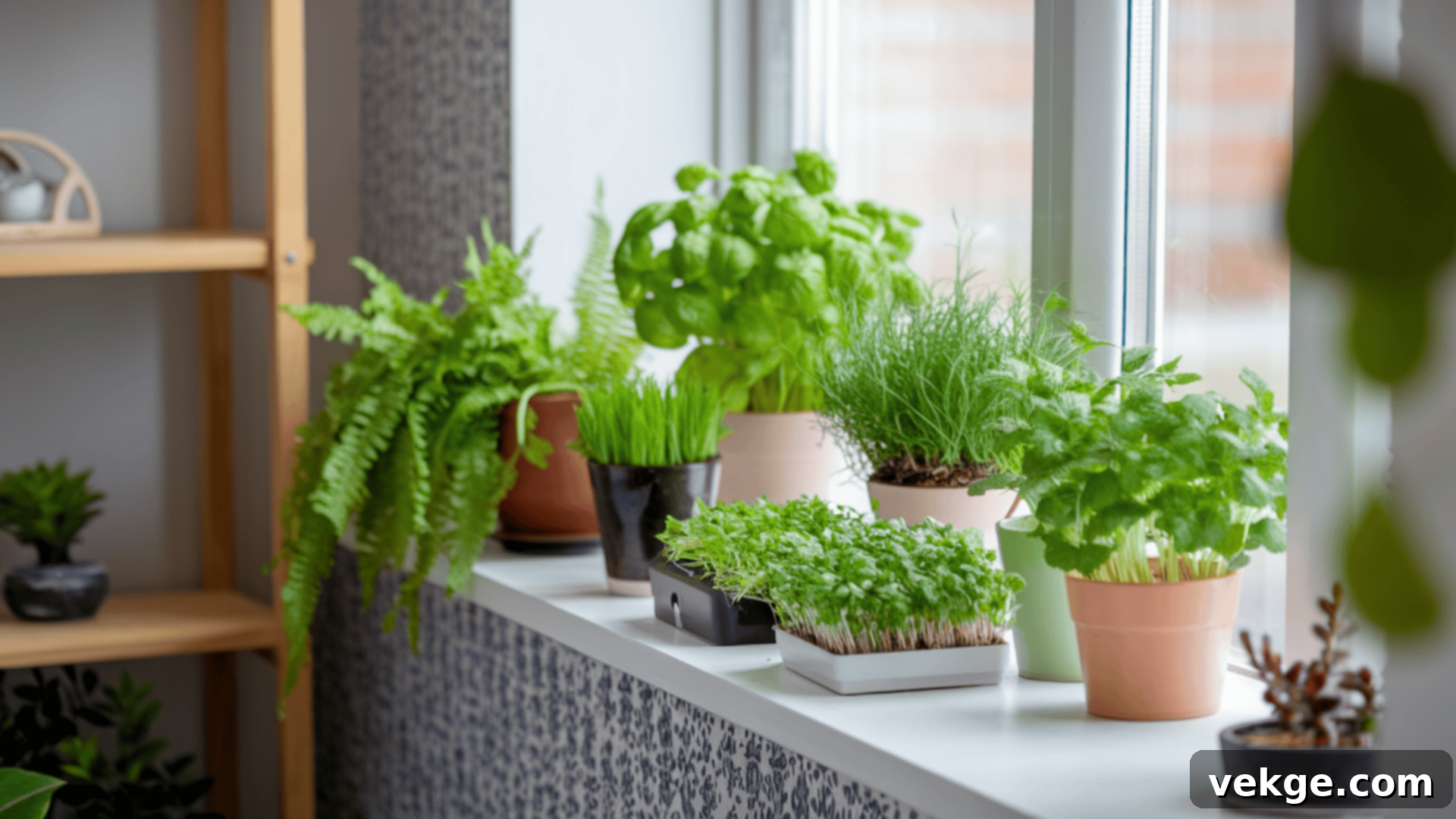
Growing Herbs and Microgreens Inside
Winter’s chill outside doesn’t mean your gardening activities have to come to a halt. Indoor gardening offers a fantastic way to keep fresh flavors within reach throughout the coldest months. Herbs and microgreens are particularly well-suited for indoor cultivation, providing a continuous harvest with minimal effort.
- Popular Indoor Herbs: Basil, mint, chives, parsley, oregano, and thyme thrive in pots on a sunny windowsill. Ensure pots have good drainage and rotate them regularly for even growth.
- Fast-Growing Microgreens: Microgreens like pea shoots, radish greens, sunflower sprouts, and various types of cress grow incredibly quickly, often ready for harvest in just 7-14 days. They are packed with nutrients and add a fresh burst of flavor to meals.
- Optimal Light Conditions: Place your indoor plants near a south-facing window, which typically receives the most natural light during winter. If natural light is insufficient, consider supplementing with a grow light to ensure robust growth.
Hydroponics and Container Gardening
For those without outdoor garden space or simply looking for innovative ways to grow, hydroponics and container gardening are excellent indoor solutions. These methods allow you to cultivate a wide range of plants within your home, independent of traditional soil conditions.
- Hydroponic Systems: Hydroponics involves growing plants in nutrient-rich water solutions instead of soil. Systems can range from simple DIY setups to advanced automated units. Plants often grow faster and more efficiently in hydroponics, making it ideal for leafy greens and herbs.
- Container Gardening Indoors: This is a versatile method for small spaces like apartments or balconies. Almost any plant can be grown in a container, provided it has adequate root room. Choose decorative pots for herbs, small vegetables, or even dwarf fruit trees to brighten up your living space.
- Pot Selection and Drainage: For container gardening, always use lightweight pots with good drainage holes to prevent overwatering, which is a common issue indoors. Terracotta pots allow for better airflow and evaporation, while plastic pots retain moisture longer.
Using Grow Lights for Winter Planting
With shorter daylight hours and often overcast skies, natural sunlight can be insufficient for many indoor plants during winter. Grow lights become a valuable tool, providing the necessary spectrum and intensity of light to keep plants healthy, productive, and prevent leggy growth.
- Types of Grow Lights: LED and fluorescent grow lights are popular choices for home gardeners. LEDs are energy-efficient and offer a broad spectrum, while fluorescent lights (especially T5 full-spectrum bulbs) are affordable and effective for greens and herbs.
- Optimal Light Distance: Position grow lights 6-12 inches above your plants for the best results. The exact distance depends on the light’s intensity and the plant’s needs. Too close can burn foliage, too far can lead to leggy growth.
- Set a Timer: To mimic natural cycles, use a timer to provide plants with 12-16 hours of light daily, followed by a period of darkness. This consistent schedule is crucial for plant development and prevents stress.
Embracing indoor gardening ensures that fresh greens, herbs, and even some vegetables are always within reach, making winter an enjoyable and productive gardening season.
Harvesting and Storing Winter Crops
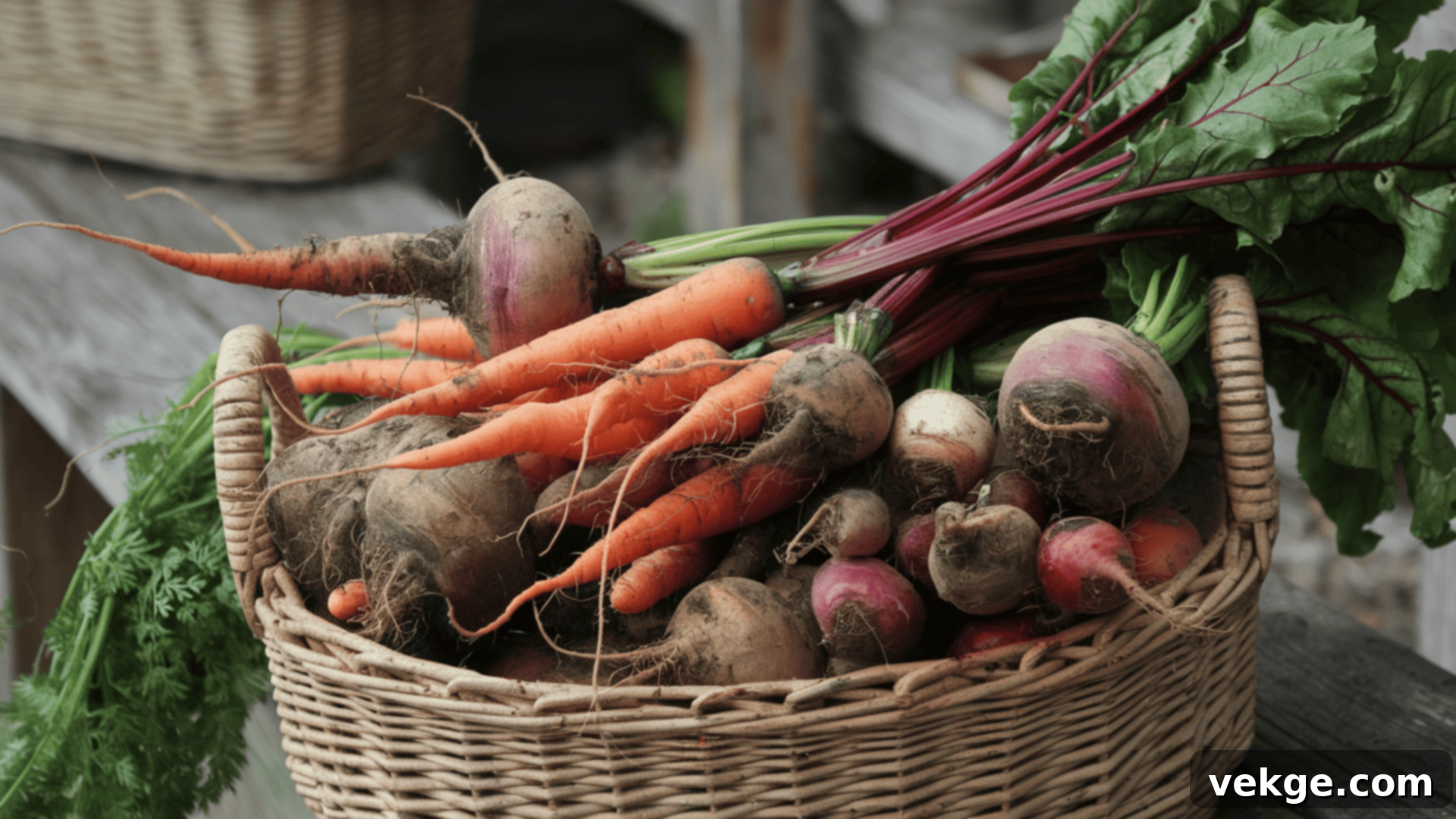
Best Time to Harvest Cold-Weather Vegetables
Harvesting winter vegetables at the optimal time is crucial for maximizing flavor and extending shelf life. Interestingly, many cold-hardy vegetables actually taste superior after being exposed to a light frost. This natural process triggers the conversion of starches into sugars, resulting in a noticeably sweeter and more complex flavor profile.
- Leafy Greens: Kale, spinach, arugula, and collard greens can be harvested continuously as needed. Pick the outer leaves first, allowing the plant’s center to continue producing new growth. They are often sweetest after a light frost but can be picked before.
- Root Vegetables: Carrots, beets, and turnips can be left in the ground well into winter, often until the soil begins to freeze solid. This allows them to sweeten up considerably. Harvest them just before a hard freeze makes digging impossible, or mulch heavily to keep the soil workable longer.
- Hardy Crops: Vegetables like Brussels sprouts and cabbage truly shine after a few frosty nights. The cold improves their flavor and texture. Harvest Brussels sprouts from the bottom of the stalk upwards as they mature, and cabbage when the heads are firm.
Storage Tips for Root Vegetables and Leafy Greens
Proper storage is essential to prolong the freshness of your winter harvest, allowing you to enjoy your homegrown produce for weeks or even months after picking. Different types of vegetables require specific conditions to maintain their quality.
- Root Vegetables: Carrots, beets, and turnips store exceptionally well in a cool, dark, and slightly humid environment, such as a basement, root cellar, or even a cool closet. Trim the greens off before storing to prevent moisture loss. They can be stored in layers of damp sand, sawdust, or simply in a perforated plastic bag to maintain humidity.
- Leafy Greens: To store leafy greens like kale and spinach, wash them thoroughly, pat them completely dry (excess moisture leads to spoilage), and then store them in an airtight container or a sealed plastic bag lined with a paper towel in the refrigerator’s crisper drawer. They can last up to 1-2 weeks this way.
- Potatoes: Potatoes thrive when kept in a dry, dark, and well-ventilated area, ideally between 45-50°F (7-10°C). Avoid storing them in direct sunlight or in the refrigerator, as both can lead to sprouting or conversion of starches to sugars, affecting flavor and texture.
By understanding the best time to harvest and implementing appropriate storage techniques, you can ensure your winter crops provide fresh, nutritious food well beyond the initial harvest, reducing waste and maximizing your gardening efforts.
Planning for Spring Gardening
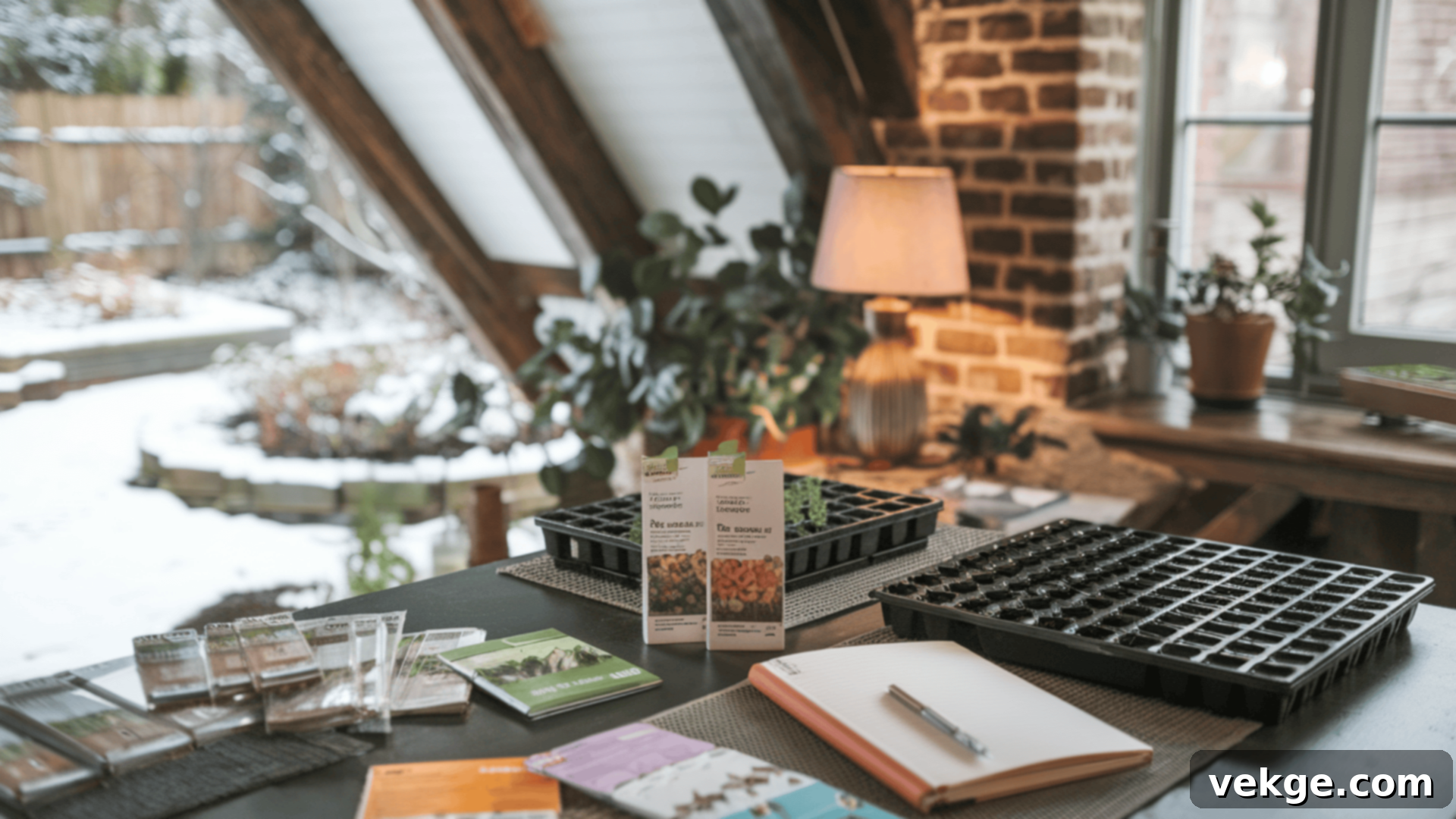
Organizing Seeds and Garden Layouts
Winter, when the garden is dormant outside, is the perfect time for thoughtful planning and preparation for the upcoming spring. Organizing your seed collection is a crucial first step. Sort seeds by type, planting time, and sun requirements to streamline the sowing process. Crucially, check the expiration dates on your seed packets; while many seeds remain viable for several years, older seeds may have significantly reduced germination rates. Mapping out your garden beds for the next season is equally important. This helps with strategic crop rotation, which is vital for maintaining soil health, preventing nutrient depletion, and naturally reducing the buildup of pests and diseases specific to certain plant families. Consider companion planting as well, where certain plants benefit each other when grown in proximity.
Preparing Raised Beds and Soil Improvement
The foundation of a strong, productive garden is healthy soil. Late winter is an excellent time to focus on soil improvement, especially for raised beds, which offer the advantage of easier access and better drainage. Begin by adding a generous layer of nutrient-rich compost to your beds. This will slowly break down over the remaining winter months, providing a vital nutrient boost for spring growth. Thoroughly remove any lingering old plant debris, which can harbor overwintering pests and disease spores. After enriching the soil, covering your beds with a layer of mulch or even a tarp can help keep the soil warm, protect it from heavy winter rains or snow, and prevent weed seeds from taking hold until planting time. A soil test in late winter can also inform specific nutrient amendments needed.
When to Start Early Spring Crops
Timing is everything when it comes to early spring planting. Some plants are remarkably cold-hardy and can withstand cooler temperatures, even a light frost, making them ideal for an early start. Crops like peas, spinach, radishes, and certain varieties of lettuce can often be direct-sown into the garden before the last anticipated frost date. For warm-season crops such as tomatoes, peppers, eggplants, and many herbs, you’ll need to give them a significant head start indoors, typically 6-8 weeks before the last frost. Once transplanted outdoors, a cold frame or a row cover can provide essential protection for these young, vulnerable plants against unexpected late frosts, giving them a better chance to establish and thrive. Remember to harden off indoor-started seedlings gradually before transplanting them outside.
A little proactive planning and preparation during the winter months will undoubtedly lead to a more organized, successful, and abundant garden when spring finally arrives.
Common Mistakes to Avoid in Winter Gardening
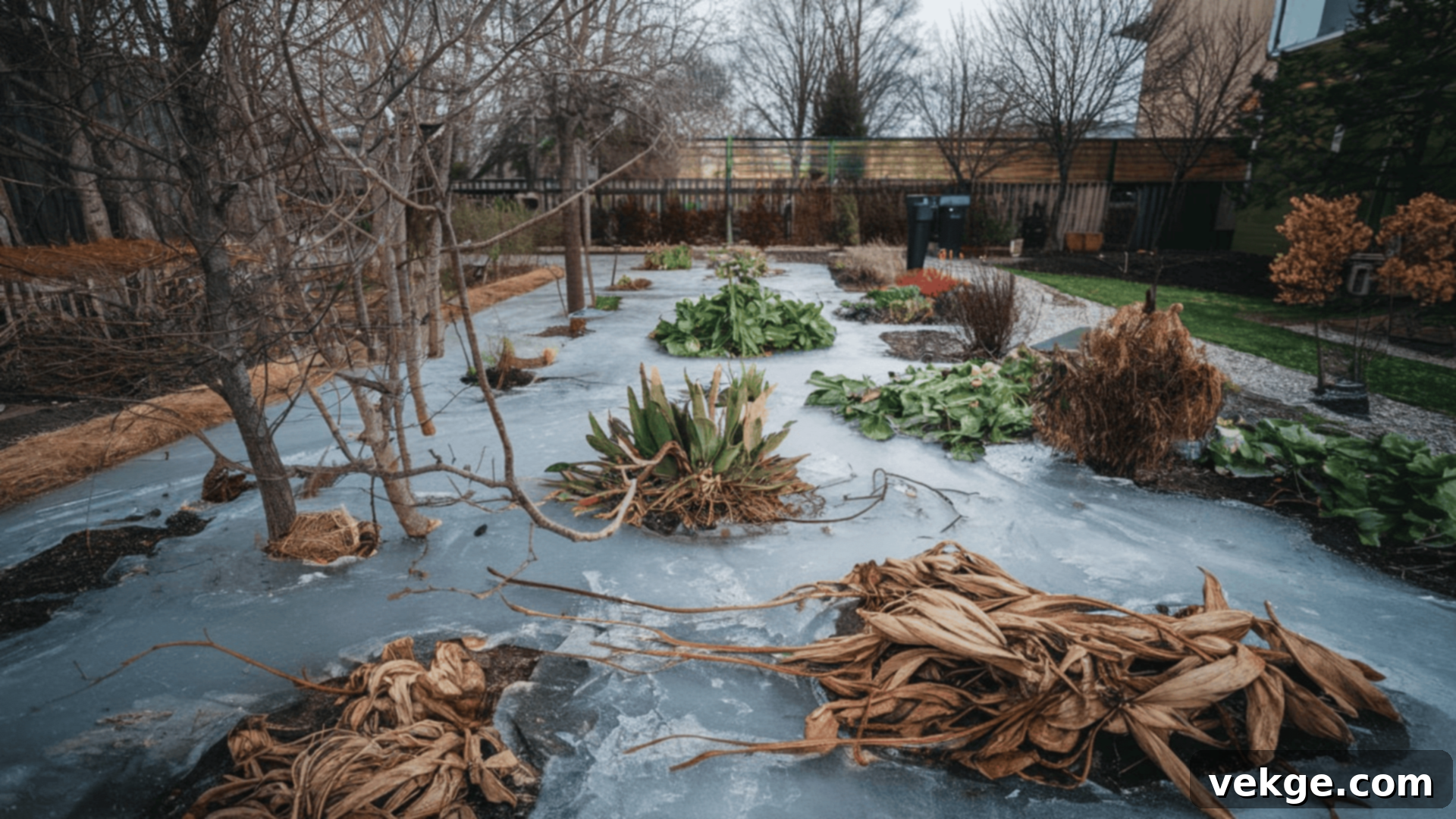
Overwatering in Cold Weather
One of the most frequent and damaging mistakes in winter gardening is overwatering. While plants need moisture, their water requirements decrease significantly in colder temperatures due to slower growth and less evaporation. Too much water can be just as harmful, if not more so, than too little. In winter, soil retains moisture longer, and excess water can quickly lead to saturated conditions. This water can then freeze around plant roots, causing significant damage or even death, a condition known as “wet feet” or root rot. Always check the soil moisture by feeling it with your finger an inch or two deep before watering. Watering deeply but infrequently, and primarily in the morning, helps prevent these issues by allowing the soil to absorb moisture and excess to drain before nighttime freezes.
Not Using Enough Mulch for Insulation
Under-mulching is another critical oversight that can jeopardize your winter garden. Mulch acts as a vital insulating layer, regulating soil temperature and protecting delicate plant roots from extreme cold, fluctuating temperatures, and damaging freeze-thaw cycles. Without an adequate layer of mulch, the soil is much more susceptible to rapid temperature changes, making roots more likely to freeze solid and experience frost heave, where plants are pushed out of the ground. A generous layer of organic mulch—such as straw, shredded leaves, or wood chips—applied 2-4 inches thick around the base of plants is essential. This not only insulates but also helps retain precious soil moisture, providing a more stable environment for your cold-hardy crops.
Choosing the Wrong Plants for Winter Growing
Attempting to grow plants that are not suited for cold weather conditions is a common source of frustration for new winter gardeners. Not all plants can handle freezing temperatures, and many warm-season varieties will simply struggle, fail to thrive, or die outright in winter. It’s crucial to research and select truly cold-hardy vegetables, herbs, and even some flowers that are known to withstand winter conditions in your specific climate zone. Sticking to proven performers like kale, spinach, carrots, beets, Brussels sprouts, and specific herbs dramatically increases your chances of success and yields. Always check the plant hardiness zone and specific cold tolerance information before planting to avoid disappointment and wasted effort later in the season.
By being mindful of these common pitfalls and implementing proactive strategies, your winter gardening journey will be much smoother, more rewarding, and result in healthier, more productive plants throughout the season.
Conclusion
Winter gardening is a deeply satisfying pursuit that is far simpler and more accessible than many assume. By understanding and implementing the right techniques and selecting appropriate plants, you can enjoy a bounty of fresh vegetables and aromatic herbs, even in the depths of the coldest months. Embracing cold-hardy crops, providing essential insulation with mulch, and utilizing protective covers like cold frames or row covers are fundamental steps to ensure your plants thrive in low temperatures. For those with limited outdoor space or facing exceptionally harsh winters, indoor gardening methods such as containers or hydroponics offer fantastic alternatives, ensuring fresh greens are always within arm’s reach.
Beyond the immediate harvests, winter is also an invaluable time for planning and preparation. Thoughtful organization of seeds, diligent soil preparation, and giving early spring crops a head start indoors lay the groundwork for an incredibly successful and vibrant garden when warmer weather returns. By avoiding common mistakes like overwatering or choosing unsuitable plants, your winter gardening experience will be significantly more rewarding and efficient.
With a strategic and informed approach, your garden doesn’t have to be a seasonal endeavor; it can remain a continuously productive, green, and inspiring space all year round. Embrace the challenge, enjoy the process, and savor the unique flavors of your winter harvest. For more expert gardening tips and seasonal advice, be sure to explore the other insightful blogs and resources available on our website!
Frequently Asked Questions
Can I Start Winter Gardening If I Missed Fall Planting?
Absolutely! While fall planting offers a head start, you can still begin winter gardening in early winter, especially for fast-growing leafy greens. Start seeds indoors or in a sheltered cold frame/greenhouse. Once they’ve established a few true leaves and conditions slightly improve (e.g., a break in extreme cold), you can move them into a protected outdoor bed, ensuring they have adequate light and frost protection.
Do I Need a Greenhouse for Winter Gardening?
No, a full greenhouse is not always necessary for successful winter gardening. Many cold-hardy winter crops can thrive with simpler, less expensive protective structures like cold frames, mini hoop houses, or even just layers of row covers. For consistent indoor harvests, container gardening on a sunny windowsill or setting up a small hydroponic system are excellent and often more practical alternatives for many home gardeners.
Why Are My Winter Plants Growing Slowly?
Slower growth in winter is entirely normal for most plants. The primary reasons are reduced sunlight hours, lower light intensity, and cooler ambient temperatures. Plants’ metabolic processes naturally slow down in these conditions. To encourage better growth, ensure plants receive maximum available light (using grow lights if indoors), provide adequate warmth with row covers or cold frames, and ensure the soil is rich in nutrients, perhaps by top-dressing with compost.
How Do I Prevent Pests in Winter?
Winter pest prevention focuses on sanitation and vigilance. Start by thoroughly removing all plant debris, fallen leaves, and spent crops from your garden beds, as these provide hiding spots for overwintering pests. Regularly check under mulch layers for slugs, aphids, or other insects. Avoid overwatering and ensure good air circulation, as damp, stagnant conditions can encourage fungal gnats and other moisture-loving pests. Maintaining a clean garden significantly reduces pest populations for the coming spring.
